The Louisville-Elizabethtown-Scottsburg CSA
This article is the last in a series of seven highlighting each of Indiana's combined statistical areas (CSAs). CSAs are groupings of predefined metropolitan (metro) and/or micropolitan (micro) areas that, as the title suggests, combine these areas to “represent larger regions and reflect broader social and economic interactions.” (1)
The Area
There are 16 counties in the Louisville-Elizabethtown-Scottsburg CSA, five of which are within Indiana's borders: Clark, Floyd, Harrison, Scott and Washington counties. The other 11 are in neighboring Kentucky: Bullitt, Hardin, Henry, Jefferson, Larue, Meade, Nelson, Oldham, Shelby, Spencer and Trimble counties. The CSA's 1.4 million residents ranked it 31st among the 121 CSAs in the nation and fourth among Indiana's seven CSAs. Indiana's five counties contributed about 265,000 people to the population, or 19.5 percent.
Since 2000, the Louisville-Elizabethtown-Scottsburg CSA has added more than 60,800 people, and the Indiana portion of the CSA made up about 20 percent of that growth. Impressively, none of the 16 counties lost population from 2000 to 2006 (see Figure 1).
Figure 1: Change in Population in the Louisville-Elizabethtown-Scottsburg CSA, 2000 to 2006
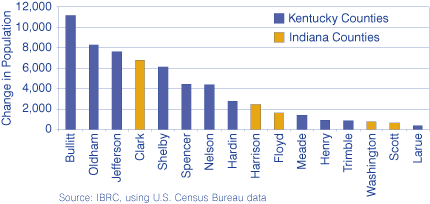
Jobs
The three largest industry sectors in the Louisville-Elizabethtown-Scottsburg CSA are manufacturing, retail trade, and health care and social services, with each making up more than 11 percent of total jobs in the area. Of the three, only health care and social services saw a gain in jobs from the second quarter of 2001 to 2006, adding more than 8,800 jobs over that time span (an increase of 14.1 percent). Meanwhile, manufacturing and retail trade saw combined losses of more than 15,600. The same directional trends are visible at the state level as well—in both Indiana and Kentucky (see Figure 2).
Figure 2: Change in Jobs in the CSA and Respective States, 2001:2 to 2006:2
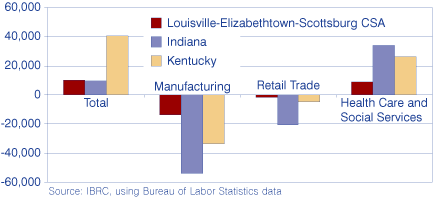
So which side of the border was responsible for most of the changes in the CSA? Keep in mind that the Kentucky portion of the CSA made up about 84 percent of jobs in the CSA in both 2001 and 2006. Therefore, it is reasonable to expect both losses and gains to be magnified for Kentucky relative to Indiana. This holds true for overall job change, manufacturing, and health care and social services; but a closer look reveals that the Indiana portion of the CSA actually added jobs in the retail sector from 2001 to 2006 while the Kentucky portion experienced losses (see Figure 3).
Figure 3: Change in Jobs within the Louisville-Elizabethtown-Scottsburg CSA, 2001:2 to 2006:2
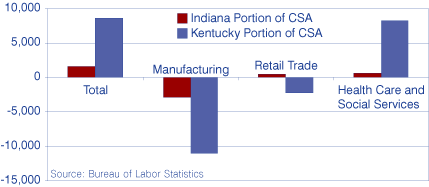
Despite losses in two of the three major industry sectors, the Louisville-Elizabethtown-Scottsburg CSA saw an overall increase in jobs of 1.6 percent over the five-year span. Compare this to a 0.3 percent change for the state of Indiana overall and 2.3 percent for Kentucky. Two industries besides the health care and social services industry had increases of at least 5,000 jobs: the finance and insurance industry (5,923 jobs for a 20.4 percent increase) and administrative, support and waste management (5,310 jobs for an increase of 15.2 percent).
Wages
Workers in the CSA were paid higher wages across all industry sectors than the average Hoosier or Kentuckian, averaging $719 per week, $684 per week and $672 per week, respectively (see Figure 4). CSA wages increased $112 per week from 2001 to 2006. Management of companies and enterprises paid more than any other major industry in the CSA, Indiana and Kentucky. The Louisville-Elizabethtown-Scottsburg CSA paid workers in this industry an average of $1,592 per week—up $396 from five years prior.
Figure 4: Average Weekly Wages, 2006:2
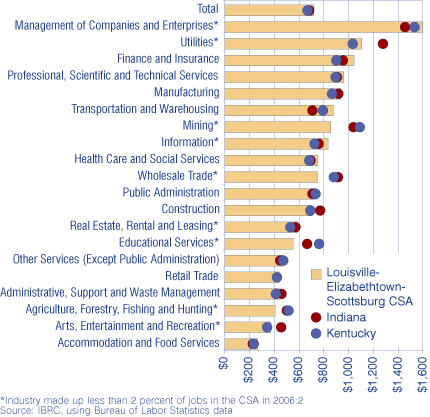
The utilities industry in the CSA took a hit over the past five years, bringing wages down closer to the state averages for Indiana and Kentucky. In 2001, the CSA paid an average of $1,534 per week, but that dropped by $428 for 2006. While both Indiana and Kentucky increased wages in the utilities industry, the three areas are now more comparable in the amount paid: The CSA, at $1,106 per week on average, hovers between the Indiana ($1,280 per week) and Kentucky ($1,037 per week) state averages. That said, the utilities industry makes up a small 0.1 percent of jobs in the area, so let's take a closer look at some of the larger industry sectors.
Of the industries that made up at least 2 percent of jobs in the area, finance and insurance paid the most, averaging $1,043 per week. At the other end of the spectrum, accommodation and food services paid the least, with workers bringing home an average of $268 per week—a figure only $26 higher than five years earlier.
Commuting
There were about 597,000 workers living and working in the Louisville-Elizabethtown-Scottsburg CSA according to Census 2000 data. Of those, about three-quarters lived and worked in the same county. Kentucky (not including counties in the CSA) contributed more workers than Indiana to the area, supplying nearly 14,400 workers to the area compared to Indiana's 6,000 (see Figure 5). Meanwhile, 21,558 workers left the CSA to work elsewhere.
Figure 5: Commuting Patterns in the Louisville-Elizabethtown-Scottsburg CSA, 2000
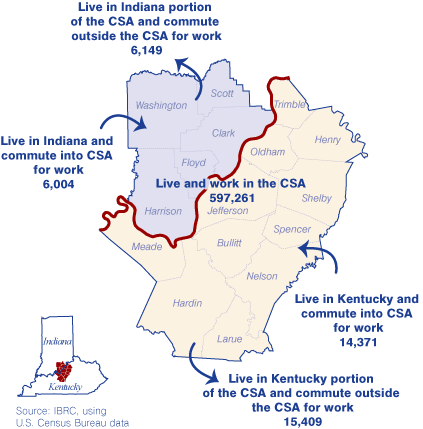
Notes
- U.S. Office of Management and Budget, available at www.whitehouse.gov/omb/.
Molly Manns, Associate Editor
Indiana Business Research Center, Kelley School of Business, Indiana University
